Pomegranate – Punica granatum is native to Southwest & Central Asia. It has been cultivated in Caucasus (Georgia, Armenia, Azerbaija), Mediterranean (Turkey, Spain, Italy) and also Iran, Malaysia, East Indies and Africa since ancient times. Then it has been spread to Latin America by Spanish settlers and later also to California and Arizona.
There are many different varieties of pomegranate, their colour can vary from yellow-red, through deep red to deep purple or almost black. The interior of pomegranate is separated by white spongy walls into compartments with seeds dressed in translucent white, pink, light or dark red pulp that has tart but delicious, fresh and juicy flavour which can be eaten raw or used in cooking or squeezed to produce juice.
NAMES
In many languages the name “pomegranate” comes from two Latin words “pomus” meaning – apple and “granatus” meaning – seeded.
Other names for Pomegranate are: Granat in Polish, Granatapfel in German, Granada in Spanish, Romã in Portuguese, Grenade in French, Nar or Rumman in Turkish, Anar or Darim or Anardana in Hindi.
WHEN IN SEASON
Pomegranates are in season from September to February in Northern Hemisphere and from March to May in Southern Hemisphere.
CONSUMPTION
Pomegranate can be easily open by scoring the skin (in four) and then breaking it open. I did not know if before I did this research on the pomegranates that is why on the second picture it is halved with the knife…
Uses of pomegranates:
- to make juice, California is a big producer of pomegranate juice
- to make Grenadine syrup used in cocktails or traditional Iranian savoury dishes
- dried seeds (Anar) are used as spice for chutneys and curries
- in Turkey pomegranate sauce is used as dressing for salads or to marinate meats
- in Azerbaijan pomegranate sauce Narsharab is served with fish or kebab
- in Syria and Turkey pomegranate molasses are used to produce Muhammara spread containing roasted red peppers, garlic and walnuts
- in Armenia and Israel wine is produced from pomegranates
- in Greece Kollivozoumi soup made of pomegranates, wheat and raisins is made
- used in salads or as a garnish
- pomegranate glaze is used for lamb kebabs
- for pomegranate-eggplant relish
- to make avocado-pomegranate guacamole dip
- as ice cream topping
- as yogurt or cereal topping
- in Cyprus and Greece they are used to make Kolliva: mixture of wheat, pomegranate seeds, sugar, almonds and other seeds served at memorial services
NUTRITIONAL VALUES
Pomegranate juice very rich in vitamin C, is a good source of vitamin B5 (pantothenic acid), potassium and antioxidants.
- Some information source Wikipedia.
- Please correct me or let me know if I missed something and I will add it to the post.
- I promised myself to use more pomegranates now when they are in season in Europe so you can expect some recipes very soon… for now some of my bookmarked recipes that I would love to try:
– Pomegranate Salad by AZ Cookbook
– Pomegranate & Caramelized Pear Panna Cottas by Tartelette
– White Chocolate Mousse with Pomegranate Sauce by Noble Pig
– Brussels Sprouts with Walnuts and Currants or Pomegranate Seeds by Running with Tweezers
– Breaded Goat Cheese Salad with Dried Fruit and Pomegranate by Veggie Belly
– Fruit Salad with Pomegranate, Grapes, Ginger and Walnuts by Lucullian Delights
– Pomegranate Salad with Arugula by Elana’s Pantry
– Pistachio, Pomegranate and Orange Biscotti by Cook (almost) Anything At Least Once
– Pomegranate & Mint Frozen Yogurt by eCurry
– Pomegranate Chicken Tagine by Feeding Maybelle
– Muhammara by Closet Cooking
– Chickpea & Pomegranate Dip by Once Upon a Feast
– Pomegranate Sweet-n-Sour Fish on Chard’s Flan by Kitchen Unplugged
– Chickpea and Pomegranate Molasses Dip by A Spoonful of Sugar
– and some more on Pomegranate.org website
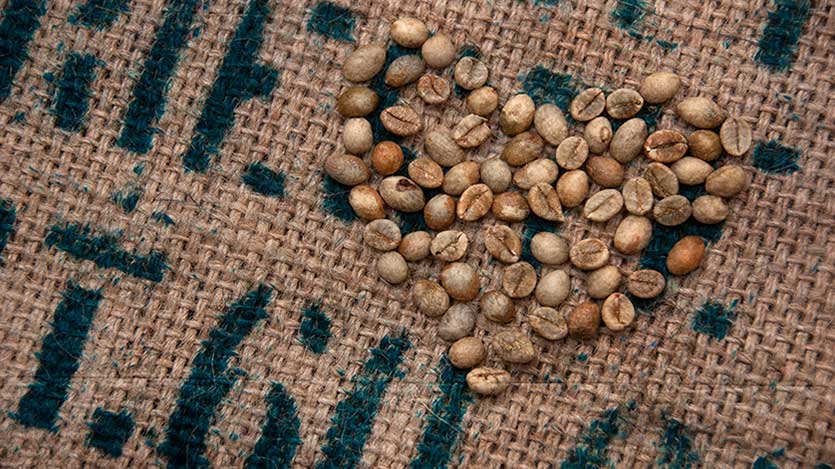
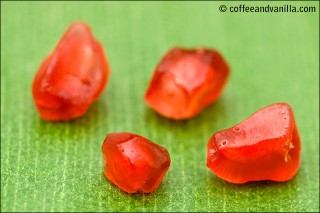
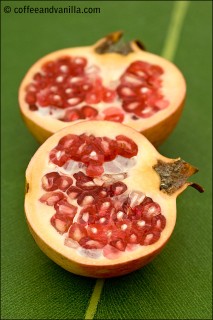
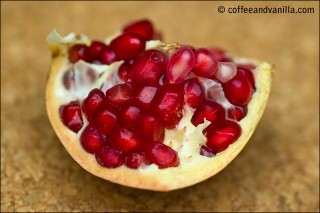
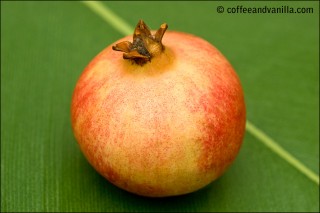
november is national pomegranate month!
Margo, I also love the sweet little rubies in this lovely fruit. I picked up a couple of them last night, and intend to snack on them, in the raw. That would be the fruit, not me [g]
Enjoy your weekend.
Thanks for mentioning the dip. Now I’m off to try all those other delicious treats.
Pomegranate is a true jewel and a treasure. Nice Information and thanks a bunch for the link.
Great pomegranate post with lots of good information and links! I have really been into pomegranates the last few weeks. (I just need to find some time to start posting about them. :)
Here in Indonesia, the name for pomegranate is Buah Delima and I think the name came from Batu Delima which is Ruby stone :)
trans: buah means fruit, batu means stone)
Need to try this soon…love the photo of the seeds, they look glassy, just like beads!